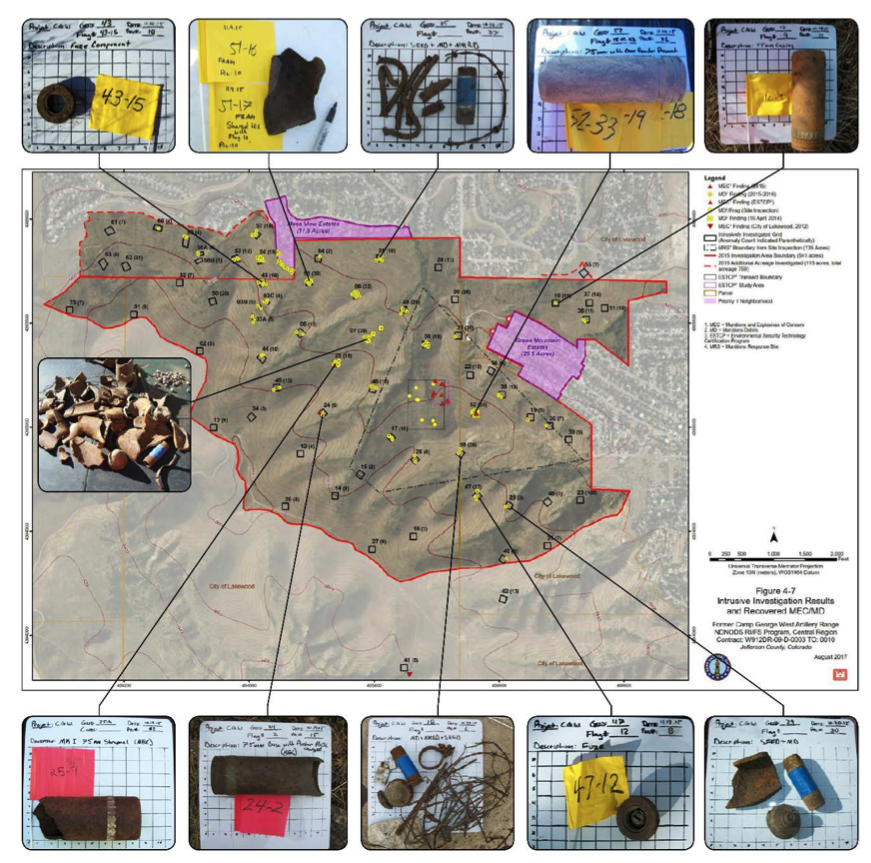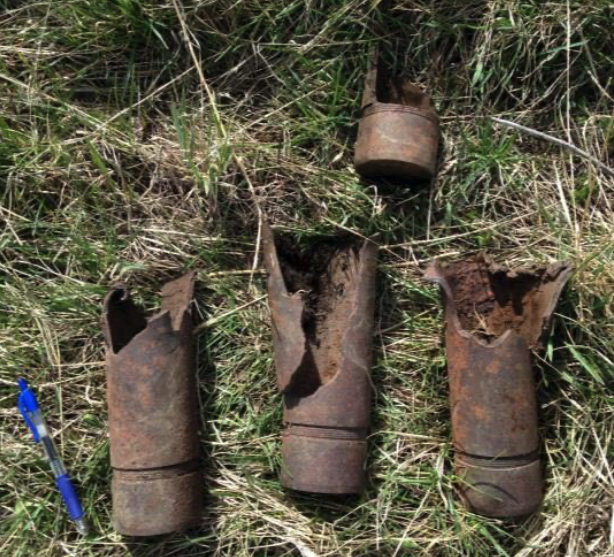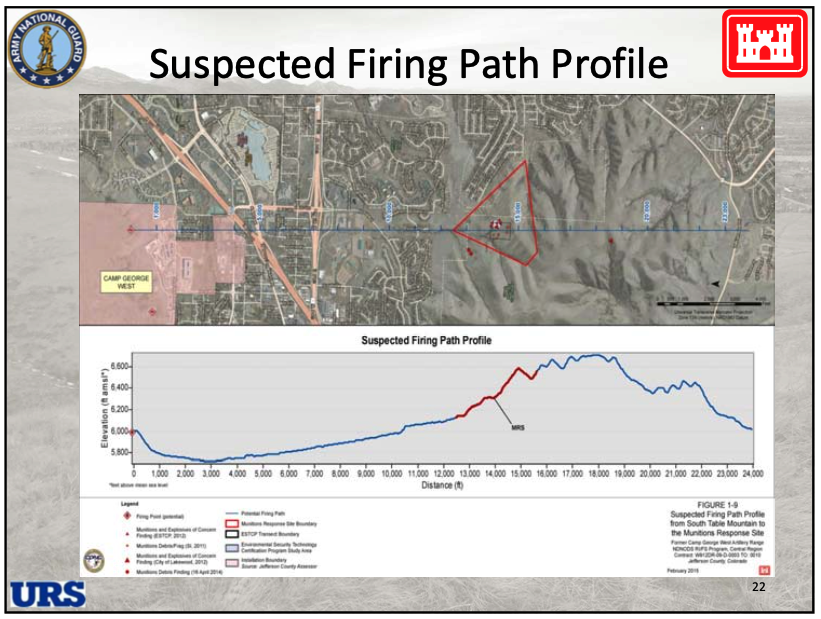LAKEWOOD, Colo. — More than a decade after historic military munitions were first found on Lakewood's Green Mountain, a comprehensive, in-depth sweep for any remaining items is planned for the spring of 2024.
Initial assessments have already been done to remove munitions, but a more thorough evaluation is planned for sometime in the spring of 2024, according to Lt. Col. Brian Hunsaker, branch chief for cleanup and restoration at the National Guard Bureau in Arlington in Virginia.
Signs were initially installed at the northern trailheads to Green Mountain's William F. Hayden Park in 2010 after the first piece of military debris was found. The notices were updated in 2020 to notify visitors about the possibility of historic military artillery.
The signs warn, "Caution Historic Military Artillery Use Area" in capital red letters, and "Pieces of spent artillery shells from prior to WWII have been found in the park and this indicates a potential that unexploded pieces of artillery could be in the park."
Since January 2010, the Colorado Department of Public Health and Environment (CDPHE) has worked with the City of Lakewood and Colorado National Guard (CDPHE oversees the National Guard's investigations and cleanup activities) to determine if pre-WWII military activities had any impact on Green Mountain.

Why were they so focused on that green mound in Lakewood? And how did military artillery find its way over there?
That's because Camp George West used Green Mountain's northern slopes as the Colorado National Guard's permanent rifle range and training facility in preparation for World War II. The camp was founded in 1903 and set up near the junction of W. Colfax Avenue and Interstate 70.

It was an ideal place for the camp, which could draw from Denver's population and was accessible by road and rail. In addition, the area around the camp was not yet populated.
It was officially designated Camp George West on May 1, 1934.
According to historical documents, the Colorado National Guard leased part of Green Mountain from the William F. Hayden family — the current park's namesake — in the 1930s to use as an artillery impact area for rounds fired from Camp George West.

Most of the munitions used were 75mm projectiles and shrapnel shells, as well as high explosive projectiles. And while most exploded as normal during training exercises, some were faulty and instead, became lodged in the ground.
Training at Camp George West ultimately ended in the 1940s after the conclusion of WWII, though the Colorado National Guard continued to use it in ways that did not include mechanized tanks and artillery. But even this dwindled into the 1960s, after rail service in the area ended. Years later, it was listed on the National Register of Historic Places as a historic district on Feb. 11, 1993.
The years ticked by. And so the pre-WWII munitions sat quietly, some on the surface of the mountain and others embedded in it, for decades. (Editor's note: The National Guard said prior sweeps from different agencies could have occurred, but there was likely poor documentation of them and therefore, no information on it in their databases.)
It wasn't until 2008, when a grass fire burned the northern slopes of Green Mountain, that the Colorado National Guard was alerted to the munitions.

In February 2010, a man was walking in the previously burned area on the north side of Green Mountain and found an ordnance, Hunsaker said. He picked it up and brought it to authorities, though Hunsaker said he should have left it and alerted officials instead.
It ended up being ammunition debris item, or MD.
"He found it, brought it to the attention of the fire department and they brought it to our attention eventually through many layers, and so we started what's called the CERCLA process, which is the federal law that was passed in the 1970s," he explained.
CERCLA, which stands for the Comprehensive Environmental Response, Compensation, and Liability Act, is better known as Superfund. It is a federal environmental remediation program. The Camp George West Artillery Range is not a Superfund site, though the same guidelines for investigation and cleanup exist. The CDPHE said it partnered with the National Guard to select a remedy that meets CERCLA requirements.
The CDPHE said 2010 was the first year the signs went up along the northern trailheads of Green Mountain (they were later updated in 2019).
Hunsaker explained that it took a few years to determine why the ordnance was found on Green Mountain.

“It took us a while to figure out how it got there, because there was no record of it," he said of the rifle training range. "Since it had been discontinued as early as 1939, nobody was left alive that knew that there were artillery rounds there."
In September 2011, the National Guard completed an initial site inspection of Green Mountain's high-traffic areas to significantly reduce the chances of somebody on-trail coming across a munition, the CDPHE said. During that search three MDs were found during a visual survey, which led to a recommendation for a remedial investigation. Within a year, a member of the public found an additional MD. A munition and explosive of concern (MEC) item was also found.

In 2013, a MD and nine MECs were recovered. Three MDs were found in 2014 by a contractor and, in 2015, three MEC items were recovered, as well as one MD, during a remedial investigation.

Many of the items were 4 to 8 inches underground, according to the CDPHE. The deepest one was about 15 inches.
All of them were removed.
In the initial assessments, the National Guard used what Hunsaker described as an industrial strength metal detector to search Green Mountain. He explained that as the device rolls across the ground, it provides imaging down to about three feet.
"It sends a lot of radio waves down to the ground and we get a good image and then we know when to dig," he said. "Very carefully, we dig anything out that is suspected (or) identified by the explosive ordnance teams and they determine whether it's safe to move it."

Trained military munitions experts then moved, inspected, removed or, if hazardous, detonated, the items. It's decided on a case-by-case basis. The National Guard said over the course of the project, there have been some munitions found that required detonation and, when they were discovered, that detonation occurred safely on site.
The CDPHE said a remedial investigation took place in 2016 and 2018 and included a field investigation of portions of Hayden Park between 2015 and 2018, and adjacent residential yards in 2018 and 2021.
Both Hunsaker and the CDPHE said based on the preliminary assessments and metallic scanning, no munitions were found in the nearby neighborhoods and it is unlikely any are still there.
Remediation of munitions began in 2020 after extensive planning, extensive public engagement and a timeline for future similar work, according to a Lakewood City Council staff memo from June 12. The National Guard secured funding for this in 2022 and along with CDPHE and its other partners, are developing the first phase of the remedy — that is the full, thorough sweep planned for the spring and summer of 2024.
“Once that's done, we will make sure that the land use controls are put into place, and we’ll kind of monitor it see if anything changes, like significant weather events — if there's another fire, if there's some major flood or something that will move a lot of dirt, then we'll come inspect those areas again," Hunsaker said.
Monitoring of Green Mountain will continue indefinitely, he said.

As for now, there is an extremely low risk of anybody finding munitions on the mountain, he added. In addition, the likelihood of munitions in the nearby neighborhoods is "small" but "possible," according to the CDPHE, which noted there are no records of construction crews coming across old munitions while building the homes.
However, the CDPHE also added the Department of Defense considered unexploded ordnance (UXO) the most dangerous category of military munitions and anybody who finds one found simply take note of its location and alert authorities.

"While it is unlikely the 75mm artillery projectiles recovered on Green Mountain would detonate from casual contact, if mishandled, however, some of the munitions could detonate, causing severe injury or death," the CDPHE said. "Only trained military munitions experts should handle suspected UXO items."
If there are any munitions on Green Mountain, they would be off-trail and on the north side of the mountain. The impact area was initially sketched out to include 135 acres in 2012, but was later increased to 466 acres during remedial investigation fieldwork in 2018, CDPHE said. It includes the nearby neighborhoods of Mesa View Estates and Green Mountain Estates out of an abundance of caution.
The CDPHE warns that these military items should all be considered dangerous, as they were designed to destroy military supplies and kill people. The department recommends anybody in this area of Lakewood to remember the "three R's of munition safety," which are as follows:
- Recognize: Munitions can be difficult to see and identify. They may look like a pointed pipe, soda can, baseball or muffler, CDPHE said. They may be visible, buried or exposed by erosion, but are typically about 10 inches long and 3 inches wide.
- Retreat: If you believe you have found a munition, don't touch it. Walk away carefully and if you can, mark the area with one of your belongings or natural items, like sticks or rocks.
- Report: Call 911 to report the munition, and include what and where you saw it.
As of now, project facts sheets for planning of munitions cleanup for the summer of 2023 and a community relations plan for 2023 are both still in the draft process. The cleanup plan will be available online in late 2023 and the community relations plan will become available this fall, CDPHE said.
The Camp George West property is now used by multiple organizations, including Center for Occupational and Environmental Medicine, Colorado Department of Transportation, Colorado Correctional Center and Department of Energy's National Renewable Energy Laboratory, according to the CDPHE.




